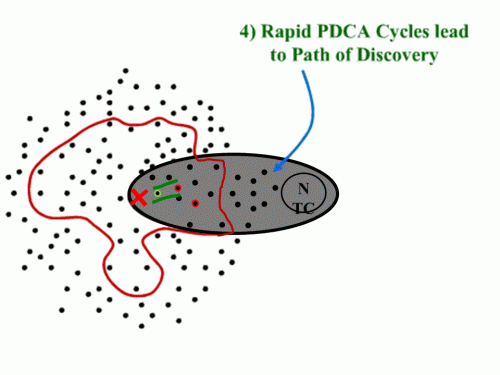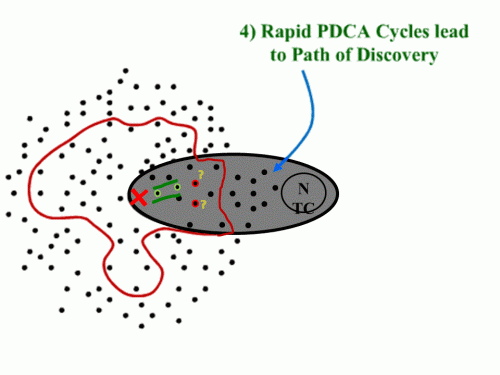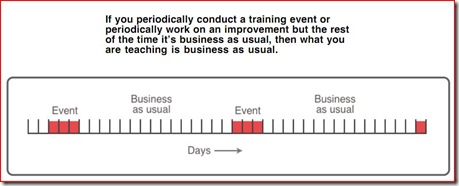On Monday MIT hosted a webinar with Steven Spear on the topic of “Creative Experimentation.”
A key theme woven throughout Spear’s work is the world today is orders of magnitude more complex than it was even 10 or 15 years ago. Where, in the past, it was feasible for a single person or small group to oversee every aspect of a system, today that simply isn’t possible except in trivial cases. Where, in 1965 it was possible for one person to understand every detail of how an automobile worked, today it is not.
My interpretation goes something like this:
Systems are composed of nodes, each acting on inputs and triggering outputs. In the past, most systems were largely linear. The output of upstream nodes was the input of those immediately downstream. You can see this in the Ford Mustang example that Spear discusses in the webinar.
Today nodes are far more interconnected. Cause and effect is not clear. There are feed-back and feed-forward connections and loop-backs. Interactions between processes impact the results as much as the processes themselves.
Traditional management still tries to manage what is inside the nodes. Performance, and problems, come from the interconnections between nodes more than from within them.
The other key point is that traditional management seeks to first define, then develop a system with the goal of eventually reaching a steady state. Today, though, the steady state simply does not exist.
Product development cycles are quickening. Before one product is stable, the next one is launched. There is no plateau anymore in most industries.
From my notes – “The right answer is not the answer for very long. It changes continuously.”
Therefore, it is vital that organizations be able to handle rapid shifts quickly.
With that, here is the recorded webinar.
(Edit: The original flies have been deleted from the MIT server.)
A couple of things struck me as I participated in this.
Acknowledging that Spear has a bias here (as do I), the fact that Toyota’s inherent structure and management system is set up to deal with the world this way is probably one of the greatest advantages ever created by happenstance.
I say that because I don’t believe Toyota ever set out to design a system to manage complexity. It just emerged from necessity.
We have an advantage of being able to study it and try to grasp how it works, but we won’t be able to replicate it by decomposing its pieces and putting it back together.
Like all complex systems, this one works because of the connections, and those connections are ever changing and adapting. You can’t take a snapshot and say “this is it” any more than you can create a static neural net and say you have a brain.
Local Capability
One thing that emerges as critical is developing a local capability for this creative experimentation.
I think, what Spear calls “creative experimentation” is not that different from what Rother calls the “improvement kata.” Rother brings more structure to the process, but they are describing essentially the same thing.
Why is local capability critical? Processes today are too complex to have a single point of influence. One small team cannot see the entire picture. Neither can that small team go from node to node and fix everything. (This is the model that is used in operations that have dedicated staff improvement specialists, and this is why improvements plateau.)
The only way to respond as quickly as change is happening is to have the response system embedded throughout the network.
How do you develop local capability? That is the crux of the problem in most organizations. I was in an online coaching session on Tuesday discussing a similar problem. But, in reality, you develop the capability the way you develop any skill: practice. And this brings us back to the key point in Kata.
Practice goes no good unless you are striving against an ideal standard. It is, therefore, crucial to have a standardized problem solving approach that people are trying to master.
To be clear, after they have mastered it, they earn a license to push the boundaries a bit. But I am referring to true mastery here, not simple proficiency. My advice is to focus on establishing the standard. That is difficult enough.
An Example: Decoding Mary – Find the Bright Spots
Spear’s story of “Decoding Mary” where the re-admission rate of patients to a hospital directly correlated with the particular nurse handled their transfer reminded me of Heath & Heath’s stories from Switch. One of the nine levers for change that they cite is “find the bright spots.”
In this case the creative experimentation was the process of trying to figure out exactly what Mary did differently so it could be codified and replicated for a more consistent result independent of who did it.
The key, in both of these cases, is to find success and study it, trying to capture what is different – and capture it in a way that can be easily replicated. That is exactly what happened here.
A lot of organizations do this backwards. They study what (or who) is not performing to determine what is wrong.
Sometimes it is far easier to try to extract the essence what works. Where are your bright spots for superb quality? Does one shift, or one crew, perform better than the others? Do you even know? It took some real digging to reveal that “Mary” was even the correlating factor here.
Continuous Improvement Means Continuous Change
Since “continuous improvement” really means “continuously improving the capability of your people,” now perhaps we have “to do what.” I have said (and still say) that the “what” is problem solving.
What you get for that, though, is a deep capability to deal with accelerating change at an accelerating rate without losing your orientation or balance.
It is the means to allow the pieces of the organization to continue to operate in harmony while everything is changing. That brings us back to another dilemma: What is the ROI on learning to become very, very good? You don’t know what the future is going to throw at you, only that you need the capability to deal with it at an ever quicker pace.
But none of this works unless you make a concerted effort to get good at it.
Here is the original link to the MIT page with the video, and a download link for PDFs of the slides:
http://sdm.mit.edu/news/news_articles/webinar_010912/webinar-spear-complex-operating-systems.html






